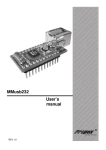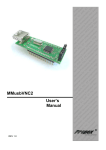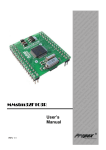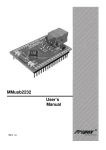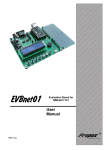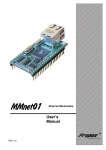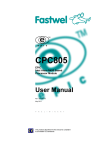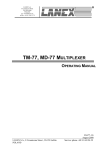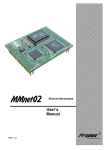Download MMusb232RL User`s manual
Transcript
MMusb232RL User’s manual REV 1.0 u rd ST, ta- rve l a oa , S e Ev B VR ers b S l d n io 1, A trol We mo t i a ‘5 in ron ed r c fo cro dd s M the e s d e i m mb oar rs, peC E B e S PI its ng roll gh r K pi nt Hi fo r y o rte tot roc FID ers s o c r Pr mi s, R mm lle rs or ler gra tro f ol n o s pr oco CB e ntr l P r u o r o c tem ic s, t m m ds f s e y n S T ste ar lS n I , sy Bo tro C d I r n n e P so tio oco eb , e a R c W r u AV pro val mic ed iro E dd ic ng PIC be ds m M ni T, m r , ig , S s E oa rs s e B t de VR Ki ng roll t h i r , A rte typ on Hig 1 c ‘5 Sta oto ro ID r e ic F rs P le rs or m s, R mm ve s f ller gra ntrl r Se ule tro pro oco r s, od on s m t c tem mic em i n ne s T st y S y r ohe In S C, r s B t e d PI eso tion ice , e R oc ua m Sp AV opr val IC e r r fo ic g E T, P mb rs s M nin , S E s ing r ig t R i e l ol des , AV er K typ B `51 tart roto roS s P mic , PC for s s ller er for lers d l ar tro erw les tro on b S du con ram c ro We imo et rog o n n p ed Mi her m roc d d ds et ste ic ar rs, Sy T m r o B olle In , S so tr ed IC oce ign P s co Spe R, opr De V cr B Rion h t ig r A Mi H f o rs PC lua , s oneasolution e Many ideas s er roll em Ev ds m nt st ng oar y o c S ni B Introduction MMusb232RL is a low-cost integrated module for data transmission via USB interface. It is based on FTDI`s FT232RL device. Mmusb232RL module can work with 1Mboud/s (RS232), 3Mboud/s (RS422/RS485, TTL) data transfer speed. It’s a simple device which represents an interface between USB and Asynchronous Serial Data Transfer. There is a USB cable attached to the module. Windows drivers allow to emulate a serial port on the PC and that provides for upgrading applications. Choosing our Minimodule is the first step for projects, which should be done in a short time. MMusb232 could be used as a part of a prototype eliminating the necessity of designing circuit board and final circuit in which module is fitted “sandwichlike” on top. MMusb232RL is made in two-layer printed circuit board technology with a solid ground plane. All signals are accessible via 24 pins, in a 100mils raster (2.54 mm) which allows to use this module with prototype PCBs. Integral power control makes the MMusb232RL a perfect choice for USB bus-powered, high power designs as well as self- and low-powered products. We wish you much success in designing and using new devices ! Features Summary • • • • • • • • • • • • • • • • • • • • • Single on-board Chip USB - Asynchronous Serial Data Transfer USB data transmission speed from 300 bod/s to 3Mbod/s (RS422, RS485, TTL level) and up to 1 Mbod/s (RS232) Integrated USB protocol on FT232RL Full Handshaking & Modem Interface Signals (by hardware or XOn/XOff) UART I/F Supports 7 / 8 Bit Data, 1 / 2 Stop Bits and Odd/Even/Mark/Space/No Parity 384 Byte Receive Buffer / 128 Byte Transmit Buffer for high data throughput Auto Transmit Buffer control for RS485 Support for USB Suspend / Resume 5 configurable lines CBUS I/O Integrated logical level converter (5V/1.8V) Adjustable RX buffer timeout FTDI drivers available Built in clock signal generator (6, 12, 24 i 48MHz) Integrated 1024bit internal EEPROM Bit bang mode (advanced asynchronous with two strobes, synchronous and asynchronous use 4 CBUS lines) Support for bus powered, self powered and high-power bus powered USB configuratoins Integrated power-on-reset circuit with optional I/O reset Integrated 3.3V regulator for USB IO Pwer supply from 3.3V to 5.25V Each circuit has its own unique ID (FTDIChip-IDTM feature) UHCI / OHCI / EHCI host controller compatible • • • USB 2.0 compatible Standard USB connector, B type Standard 6in wide 24 pin DIP socket New Features FT232R is back compatible with FT232BM, but most integrated. FT232R doesn’t need external cristal oscillator, EEPROM and USB resistors. It is not necessary to use separate power supply from the analog part. It minimalizes the amount of needed elements in the module and makes the circuit most resistant to disturbances. New Features - 5 I/O lines (CBUS0...4) which functions are possible to set using free MPPROG software - Individual polarization setting for the RS232 lines - Built-in clock signal generator, which can be connected to peripheral devices - Unique Identification Number (FTDIChipID) - Bit bang mode implemented (advanced asynchronous with two strobes, synchronous and asynchronous using 4 CBUS lines), which definitley increase application capabilities - The device operating supply current has been reduced to 15mA (VCC 3.3V - 5V) 0 / ME / XP, Linux Application Areas • • • • • • • • • • • • • • USB to RS232, RS422/RS485 converters Upgrading RS232 Legacy Peripherals to USB Cellular and Cordless Phone USB data transfer cables and interfaces Interfacing MCU based designs to USB USB Audio and Low Bandwidth Video data transfer PDA - USB data transfer USB Smart Card Readers Set Top Box (S.T.B ) PC - USB interface USB Hardware Modems USB Wireless Modems USB Instrumentation USB Bar Code Readers Audio/Video transmission General Description MMusb232RL module is a USB interface that incorporates the functionality FT232BM into a single 24-pin module. A single USB port is converted to RS232 or RS422/RS485 interface, which allows communicating with greater speed.. By using FTDI’s virtual COM port drivers, the peripheral looks like a standard COM port to the application software. Most of existing applications support VCP. User must only change the ports used by software to ports created by the driver. Using VCP the programmer can communicate with the device the same as by a regular PC COM port. Commands to set the baud rate are ignored - the device always transfers data at its fastest rate regardless of the application’s baud-rate setting. Alternatively, FTDI’s D2XX drivers allow application software to access the device “directly” through a published DLL based API. Virtual Com Port (VCP) drivers • Windows 98/ 98 SE / 2000 / ME / XP, MacOS, Linux 2.4 and greater D2XX (Direct Drivers + DLL S/W) • Windows 98 / 98 SE / 2000 / ME / XP, Linux MMusb232RL Module Simplified Block Diagram Figure 1. MMusb232RL block diagram Functional Block Descriptions 12MHz Oscillator The 12MHz Oscillator cell generates a 12MHz reference clock input to the x4 Clock multiplier from an external 12MHz ceramic resonator. Clock signal is used by SIE, USB Protocol Engine and FIFO controller. Controller includes: • • • • • • Integrated Power-On-Reset Integrated Level Converter on UART interface and control signals Improved Power Management control for USB Bus Powered, high current devices USB Suspend / Resume signals Lower Suspend Current Bit Bang Mode • • • • • • • • • USB 2.0 (full speed option) 3.3V LDO Regulator Clock Multiplier/Divider Serial Interface Engine (SIE) Dual Port TX Buffer (128 bytes) Dual Port RX Buffer (384 bytes) UART FIFO Controller Baud Rate Generator RESET Generator (More info: www.ftdichip.com) EEPROM memory The EEPROM allows customize the USB VID, PID, Serial Number, Product Description Strings, Power Descriptor value and CB0...4 lines configuration. EEPROM is integrated with the FT232R and can be programmed using a utility program available from FTDI’s web site (www.ftdichip.com) and www.propox.com Module Pin-Out Figure 2. Pin-Out Pin Definitions Pin 1 Pin’s name CB0 mode Description 3 CB1 4 CB2 5 RI input/ output input/ output input/ output input Configurable CBUS line (default TXLED#) 6 7 8 9 10 11 12 15 DCD DSR DTR CTS RTS RXD TXD RST input input input input output input output input 16 RSO output 18 20 3V3 CB4 21 CB3 22 23 24 VIO VEX VPO output input/ output input/ output input input output Configurable CBUS line (default RXLED#) Configurable CBUS line (default TXDEN#) Ring Indicator Control Input. When the Remote Wakeup option is enabled in the EEPROM, taking RI low can be used to resume the PC USB Host controller from suspend. Data Carrier Detect Control Input Data Set Ready Control Input / Handshake signal Data Terminal Ready Control Output / Handshake signal Clear To Send Control Input / Handshake signal Request To Send Control Output / Handshake signal Receive Asynchronous Data Input Transmit Asynchronous Data Output Can be used by an external device to reset the MMusb232. If not required, tie to VCC. Output of the internal Reset Generator. Stays high impedance for ~ 5ms after VCC > 3.5V and the internal clock starts up, then clamps its output to the 3.3v output of the internal regulator. Taking RESET# low will also force RSTOUT# to drive low. RSTOUT# is NOT affected by a USB Bus Reset. 3.3 volt Output from the integrated L.D.O. regulator. Configurable CBUS line (default SLEEP#) Configurable CBUS line (default PWREN#) +3.0 volt to +5.25 volt VCC to the UART interface pins Set main power supply, should be connect to VPO if powered from USB port Power supply from USB Jumpers Figure 3. Musb232RL jumpers view (top layer) Jumper JP1 JP2 Description VEX i VPO pins VEX, VIO, 3V3 pins Technical Data Dimensions Weight Power supply : 45mm x 20mm x 15mm : ~ 60 g : 5V Additional 5 pins have been placed on the board for power supply configuration. VEX and VPO connected cause supplying from USB. Last 3 pins are used for voltage level establishing: 3.3V (VIO-3V3) or 5V (VIO-VEX). Mechanical Dimensions Dimensions are in mils. 1mil – 1/1000 inch 100mils = 2,54mm Standard Device Configuration Examples USB Bus Powered (jumpers configuration - red) Figure 4. Mmusb232RL USB bus powered Figure 4 illustrates a typical USB bus powered configuration. A USB Bus Powered device gets its power from the USB bus. Basic rules for USB Bus power devices are as follows: a) On plug-in, the device must draw no more than 100mA b) On USB Suspend the device must draw no more than 500uA. c) A High Power USB Bus Powered Device (one that draws more than 100mA) should use the on-board MOSFET to keep the current drawn by external circuitry to below ~70mA on plug-in and ~200uA on USB suspend d) A device that consumes more than 100mA can not be plugged into a USB e) No device can draw more that 500mA from the USB Bus. The USB power descriptor option in the EEPROM should be programmed to match the actual current intake. External powered configuration 3.3V-5V VEX RSO RST GND Figure 5. Mmusb232RL external power supply Figure 5 illustrates a typical USB self powered configuration. A USB Self Powered device gets its power from its own Power Supply and does not draw current from the USB bus. Basic rules for USB Self power devices are as follows: a) A Self-Powered device should not force current down the USB bus when the USB Host or Hub Controller is powered down. b) A Self-Powered device can take as much current as it likes during normal operation and USB suspend as it has its own power source. c) A Self-Powered device can be used with any USB Host and both Bus and Self Powered USB Hubs. The USB power descriptor option in the EEPROM should be programmed to a value of zero (self powered). Bus powered circuit with power control – 5V power supply Figure 6. Mmusb232RL Bus powered circuit with power control – 5V power supply In case of configuration as shown on figure 6 the jumpers are not necessary. Figure 6 illustrates USB bus powered circuit configuration of Musb232RL. External (5V) devices can be powered from this module. Basic rules for USB Self power devices are as follows: a) An external device must have own power-on-reset circuit b) A Pull-down option in internal EEeprom should be set on Suspend. One of CBUS pins should be configured as PWREN# in internal EEeprom and should be used for switching the supply to external circuits. c) For devices, whitch take from USB more than 100mA current (no device can draw more that 500mA from the USB Bus) in internal EEeprom should be configured max power parameter, which inform system of required power consumption. Technical support If You have problem with MMusb232RL, please contact us at [email protected]. Schematic 12













